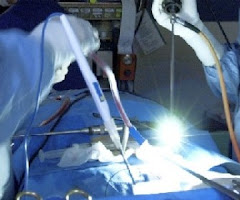The traditional, and most prevalant, approach to treating pain or disability from lumbar degenerative disc disease is spinal fusion. This surgery involves a bone graft and hardware placed to fuse two adjacent vetebrae togther. Pain relief occurs by stopping the motion of the painful disc(s). If pain recurs after the fusion, there are now alternatives available so a patient does not have to spend a life filled with pain.
An instrumented fusion can fail if there is not enough support to hold the spine while it is fusing. Spinal hardware (pedicle screws) may be used as an internal splint to hold the spine while it fuses. But like any other metal, it can break. In unstable spines, it is often a question of which will occur first – the spine fusing (and the patient’s bone then providing support for the spine) or the metal failing.
According to The New England Journal of Medicine, fusion is associated with more complications than any other type of spinal surgery. Actual clinical success in term of satisfactory improvement in preoperative pain occurs in only 50-80 % of patients undergoing spinal fusion. When a patient continues to have pain despite fusion surgery, this is generally referred to as failed back surgery syndrome (FBSS).
FBSS can be difficult to treat because it is often difficult to find what is causing the pain. The more levels that are fused and the more surgeries that are done, the less likely any further surgical intervention is going to be successful.
Arthroscopic alternatives to open surgery, such as The Bonati Procedures, offer a least invasive option to traditional open, and fusion, surgeries. These Procedures allow for greater precision, faster healing and less damage to healthy tissue. With patented instrumentation and methods, advanced spine surgeries today can employ the smallest incision possible to correct problems attributed to FBSS.
Even if a patient has had previous back surgery involving a fusion and the placement of hardware that has failed and is now producing pain, these microsurgical techniques may offer a solution.
Previously, removing misdirected hardware was avoided because the dissection required to remove hardware was as disabling as the surgery for the initial placement of the hardware. Yet now, the minimal access techniques that The Bonati Procedures employ to relieve pain from spine conditions can be employed to remove misdirected hardware with less pain, less scarring and no complications.
The patient, under local anesthesia, is alert and able to communicate with the surgeon throughout the procedure. The result can be far less trauma to the muscles and tissues, resulting in minimal blood loss and faster recovery. Patients who have had fusion surgeries that did not relieve their pain now have renewed hope with these gentle, carefully controlled outpatient procedures, which are performed sequentially. The Bonati Procedures were developed by and are performed only at The Bonati Institute® by surgical teams that have performed more than 20,000 of these advanced procedures.
To learn more about how The Bonati Procedures allow patients to regain their mobility and quality of life, visit www.bonati.com or call (866) 298-7513.
Tuesday, July 8, 2008
Subscribe to:
Post Comments (Atom)


No comments:
Post a Comment